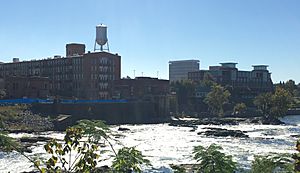Columbus metropolitan area, Georgia facts for kids
Quick facts for kids
Chattahoochee Valley
|
|
|---|---|
|
Combined Statistical Area
|
|
| Columbus–Auburn–Opelika, GA–AL Combined Statistical Area |
|

Skyline of Columbus, Georgia
|
|
| Country | |
| State | |
| Largest city | Columbus, GA |
| Other city | |
| Area | |
| • Total | 2,786.1 sq mi (7,216 km2) |
| Population
(2020)
|
|
| • Total | 328,883 |
| • Density | 118.0442/sq mi (45.5771/km2) |
| Time zone | UTC−5 (EST) |
| • Summer (DST) | UTC−4 (EDT) |
| Area code(s) | 706, 762, 334 |
The Chattahoochee Valley is a special area in the United States. It's officially called the Columbus metropolitan area. This region includes six counties in Georgia and one county in Alabama. The biggest city in this area is Columbus.
In 2020, about 328,883 people lived in the Columbus area. By 2022, the number was estimated to be around 324,110. This area is part of a larger trading region called the Columbus-Auburn-Opelika combined statistical area.
One interesting fact is that the Columbus metropolitan area is in two different time zones. The counties in Georgia are in the Eastern Time Zone. The county in Alabama, Russell County, is in the Central Time Zone. This makes it one of only two metropolitan areas in the U.S. that are split between time zones.
Contents
Geography of the Chattahoochee Valley
The Chattahoochee Valley is located in West Georgia. It includes several counties in both Georgia and Alabama.
Counties in the Area
The counties that make up this metropolitan area are:
- In Georgia: Chattahoochee, Harris, Marion, Muscogee, Stewart, and Talbot counties.
- In Alabama: Russell County.
In 2018, the U.S. Census Bureau added Stewart and Talbot counties to the official definition of the Columbus metropolitan area.
Main Communities in the Valley
The Chattahoochee Valley has many towns and cities. Here are some of the most important ones:
Larger Cities
- Columbus: This is the main and largest city in the area.
- Phenix City, Alabama: A significant city located across the river in Alabama.
- Cusseta, Georgia: This city includes the area around Fort Benning.
Smaller Towns and Places
Many smaller towns and communities are also part of the Chattahoochee Valley. These places have populations ranging from a few hundred to several thousand people. Some examples include:
- Buena Vista, Georgia
- Hamilton, Georgia
- Lumpkin, Georgia
- Richland, Georgia
- Talbotton, Georgia
- Waverly Hall, Georgia
People of the Chattahoochee Valley
The population of the Columbus metropolitan area has grown over the years. In 2000, about 281,768 people lived here. By 2010, the population increased to 296,506. As of 2020, it reached 328,883 people.
Diversity in the Community
The Chattahoochee Valley is home to a diverse group of people. In 2022, the community was made up of:
- About 43% White people.
- About 41% Black or African American people.
- About 2% Asian people.
- About 5% people of multiple races.
- About 8% Hispanic or Latino people (who can be of any race).
Income and Living
In 2022, the average income for a household in the area was about $54,106 per year. The average income per person was about $30,287. It is estimated that about 18.5% of the people in the area live with less money, meaning they are at or below the poverty line.
Getting Around the Chattahoochee Valley
The area has different ways to travel, including an airport and major roads.
Air Travel
- Columbus Metropolitan Airport: This airport helps people fly in and out of the region.
Major Highways
Several important highways pass through the Chattahoochee Valley, connecting it to other parts of Georgia and Alabama.
 Interstate 185
Interstate 185 U.S. Route 27
U.S. Route 27 U.S. Route 80
U.S. Route 80 U.S. Route 280
U.S. Route 280
See also
 In Spanish: Área metropolitana de Columbus (Georgia) para niños
In Spanish: Área metropolitana de Columbus (Georgia) para niños

